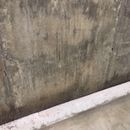Condensation at the bottom of a foundation wall
I notice today that there is a band of condensation at the bottom of the foundation walls around the entire interior perimeter of the basement. I have 2 different slab heights and one side of the house has sandy soil and the other side has clay. There is no water in the footing drains, there is a capillary break between the footings and the foundation walls, and the exterior is waterproofed from the footings to grade. It has been hot and humid here in NJ and the house is not conditioned yet. We poured the slab about a month ago, 4″ of EPS below, 2″ on the sides, 10 mil vapor barrier and 4″ GFRC. The wall is coldest pat the bottom, so if condensation is going to occur anywhere, it is there, but I am curious as to where that moisture is coming from. The slab, the interior air, the ground beneath the sub-slab EPS? I want to start installing the EPS foam on the walls, but I would prefer the walls to be dry before attempting to glue anything to them. Thoughts on where that moisture is coming from?
GBA Detail Library
A collection of one thousand construction details organized by climate and house part










Replies
Jonathan,
The moisture is coming from the interior air. The mechanism is similar to what happens when you take a cold aluminum can of beer out of the refrigerator on a hot, humid day.
The concrete is uninsulated and therefore cold. The indoor air is warm and humid. The rest is physics.
Choose a relatively dry day to install your interior rigid foam -- ideally, the concrete won't be damp when you install the rigid foam (especially if you are using adhesive). Once the basement wall is properly insulated, your worries will be over.
For more information, see "How to Insulate a Basement Wall."
Thanks Martin.
The moisture is probably coming from the slab. If you poured it a month ago, it's not dry yet. Run a dehumidifier to help dry the air and the slab. When the walls are dry to the touch, they are dry enough to install your insulation. Keep running the dehumidifier, though to dry out the house in general.
Do you have HVAC running in the house yet? Or more importantly, is the house airtight yet? If not, you will probably have to wait for a cool, dry day. A dehumidifier is going to be trying to dehumidify the planet. Run fans if you have to on a cool, dry day with the house opened up. When the walls are warmer than the air, they won't sweat.
Thanks Peter. The house is pretty well dried out as we finished framing last August, but the humidity has been brutal around here and maybe that combined with the added moisture of the new slab is causing the condensation. The Zip sheathing is up and taped, roof is on and I have most of the windows taped, but the house is not airtight yet. I should be done by the end of the month at which point I will perform my blower door test which will allow us to finalize our Manual J and mechanical spec's and start installing those in September. I think I will change my plans and move the basement insulation back to October. I have plenty of stuff to do in the meantime!